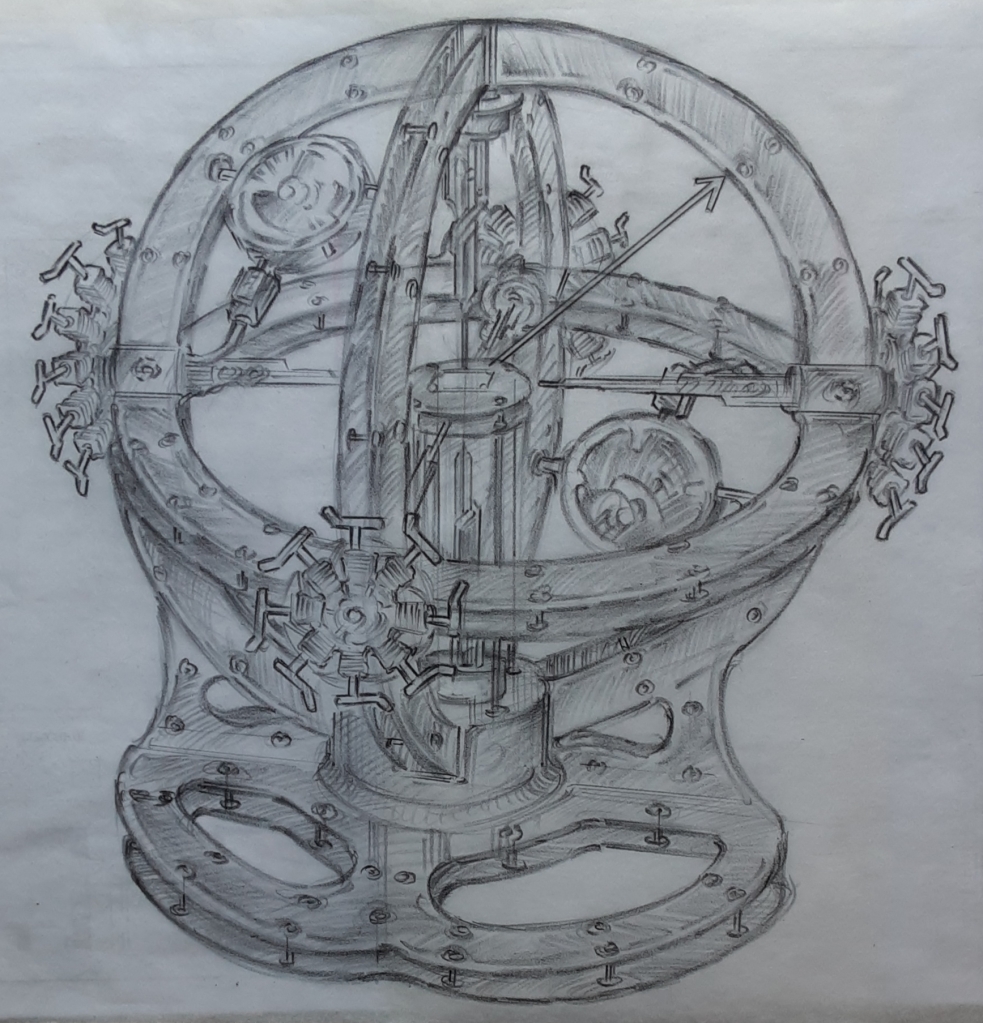In 2020, many of us logged experiences that we’d never anticipated. I wrote a nonfiction book and got married outside the Harvard Faculty Club (because nobody was around to shoo us away). Equally unexpectedly, I received an invitation to collaborate with a professional artist. One Bruce Rosenbaum emailed me out of the blue:
I watched your video on Quantum Steampunk: Quantum Information Meets Thermodynamics. [ . . . ] I’d like to explore collaborating with you on bringing together the fusion of Quantum physics and Thermodynamics into the real world with functional Steampunk art and design.
This Bruce Rosenbaum, I reasoned, had probably seen some colloquium of mine that a university had recorded and posted online. I’d presented a few departmental talks about how quantum thermodynamics is the real-world incarnation of steampunk.
I looked Bruce up online. Wired Magazine had called the Massachusetts native “the steampunk evangelist,” and The Wall Street Journal had called him “the steampunk guru.” He created sculptures for museums and hotels, in addition to running workshops that riffed on the acronym STEAM (science, technology, engineering, art, and mathematics). MTV’s Extreme Cribs had spotlighted his renovation of a Victorian-era church into a home and workshop.

All right, I replied, I’m game. But research fills my work week, so can you talk at an unusual time?
We Zoomed on a Saturday afternoon. Bruce Zooms from precisely the room that you’d hope to find a steampunk artist in: a workshop filled with brass bits and bobs spread across antique-looking furniture. Something intricate is usually spinning atop a table behind him. And no, none of it belongs to a virtual background. Far from an overwrought inventor, though, Bruce exudes a vibe as casual as the T-shirt he often wears—when not interviewing in costume. A Boston-area accent completed the feeling of chatting with a neighbor.
Bruce proposed building a quantum-steampunk sculpture. I’d never dreamed of the prospect, but it sounded like an adventure, so I agreed. We settled on a sculpture centered on a quantum engine. Classical engines inspired the development of thermodynamics around the time of the Industrial Revolution. One of the simplest engines—the heat engine—interacts with two environments, or reservoirs: one cold and one hot. Heat—the energy of random atomic motion—flows from the hot to the cold. The engine siphons off part of the heat, converting it into work—coordinated energy that can, say, turn a turbine.
Can a quantum system convert random heat into useful work? Yes, quantum thermodynamicists have shown. Bell Labs scientists designed a quantum engine formed from one atom, during the 1950s and 1960s. Since then, physicists have co-opted superconducting qubits, trapped ions, and more into quantum engines. Entanglement can enhance quantum engines, which can both suffer and benefit from quantum coherences (wave-like properties, in the spirit of wave–particle duality). Experimentalists have realized quantum engines in labs. So Bruce and I placed (an artistic depiction of) a quantum engine at our sculpture’s center. The engine consists of a trapped ion—a specialty of Maryland, where I accepted a permanent position that spring.
Bruce engaged an illustrator, Jim Su, to draw the sculpture. We iterated through draft after draft, altering shapes and fixing scientific content. Versions from the cutting-room floor now adorn the Maryland Quantum-Thermodynamics Hub’s website.
Designing the sculpture was a lark. Finding funding to build it has required more grit. During the process, our team grew to include scientific-computing expert Alfredo Nava-Tudelo, physicist Bill Phillips, senior faculty specialist Daniel Serrano, and Quantum Frontiers gatekeeper Spiros Michalakis. We secured a grant from the University of Maryland’s Arts for All program this spring. The program is promoting quantum-inspired art this year, in honor of the UN’s designation of 2025 as the International Year of Quantum Science and Technology.
Through the end of 2024, we’re building a tabletop version of the sculpture. We were expecting a 3D-printout version to consume our modest grant. But quantum steampunk captured the imagination of Empire Group, the design-engineering company hired by Bruce to create and deploy technical drawings. Empire now plans to include metal and moving parts in the sculpture.
Empire will create CAD (computer-aided–design) drawings this November, in dialogue with the scientific team and Bruce. The company will fabricate the sculpture in December. The scientists will create educational materials that explain the thermodynamics and quantum physics represented in the sculpture. Starting in 2025, we’ll exhibit the sculpture everywhere possible. Plans include the American Physical Society’s Global Physics Summit (March Meeting), the quantum-steampunk creative-writing course I’m co-teaching next spring, and the Quantum World Congress. Bruce will incorporate the sculpture into his STEAMpunk workshops. Drop us a line if you want the Quantum-Steampunk Engine sculpture at an event as a centerpiece or teaching tool. And stay tuned for updates on the sculpture’s creation process and outreach journey.
Our team’s schemes extend beyond the tabletop sculpture: we aim to build an 8’-by-8’-by-8’ version. The full shebang will contain period antiques, lasers, touchscreens, and moving and interactive parts. We hope that a company, university, or individual will request the full-size version upon seeing its potential in the tabletop.

After all, what are steampunk and science for, if not dreaming?



That seems like a fun project. Good luck with it. I look forward to seeing results.
Will an affordable version be available for purchase? (I don’t have a 3d printer.)
Bruce’s reply is “We are planning to offer a 3D model version once we get further along with the design and fabrication. Thanks!”